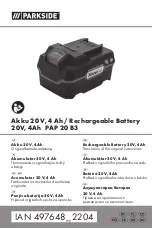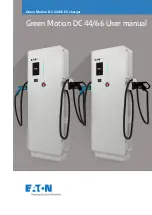
48 | SAMLEX AMERICA INC.
SCReen 4
Press “Up” Key to go to SCREEN 5
O
u
t
p
u
t
P
o
w e
r
x
x
x
x
W
a
t
t
s
oR
if the output is > 1 KW, the power will be displayed in KW as follows:
x
.
x
K
W
SCReen 5
B
a
t
t
e
r
y
S
t
a
t
u
s
x
x
.
x
v
d
c
operation In Utility Mode
(Generator Mode Disabled)
In this mode, the following input / output connections are made:
• The Utility power is connected to the AC Input terminals.
• The AC output terminals are connected to the AC distribution wiring
• The battery is connected to the Battery Input Terminals
• If a parallel external charging source (e.g. charge controller fed from
solar array or another AC charger) is required to charge the batteries,
it should be connected to the auxiliary DC input terminals
Select the “Utility Mode” through the Settings Menu
( sCreen 1, page 40).
NOTE: Please note that in the Settings Menu, “Utility Mode” is
selected by selecting “Generator Disable”.
Use this mode when the AC input source is utility / grid. As the frequency
of the utility / grid AC power does not vary widely, the “Utility Mode”has
a narrower window of + 5 Hz and – 3 Hz to allow transfer / bypass of the
utility power to the load and carry out battery charging. This restricted
frequency window is appropriate for safe and reliable operation of
frequency sensitive loads.
The G4 Series comes preset in the “Utility Mode”.
!
CAUTIon!
Please do not operate in the “Utility Mode” if a
generator is used as the AC input power source
because if the frequency variation of the generator
is more than + 5 Hz / - 3 Hz, the G4 will not transfer /
bypass the generator output to the load / charge the
batteries. If the output frequency of the generator
is not stable and varies by +5 Hz / - 3 Hz, please
operate the G4 in the “Generator Mode”.
!
ATTENTION!
Veuillez ne pas utiliser la mode «Utility mode» si le
générateur est utilisé comme source de puissance
d'entrée CA parce que si la variation des fréquences
du générateur est plus que 65 Hz ou moins que
57 Hz, le G4 ne peut pas transferer la sortie du
générateur à la charge/recharger les batteries. Si la
fréquence de la sortie du générateur n'est pas stable,
est au-dessus/en-dessous de ces limites , veuillez
faire fonctionner le G4 dans la mode «Generator
mode».
Transfer From Inverter Mode To Utility
Mode & Vice Versa
Whenever the G4 Series is switched on, it will always start in the
“Inverter Mode” first even if external utility or generator input is
available. The output of the inverter ramps up from around 40 vAC to
120 vAC in around 350 ms under "Soft Start" and is slowly synchronized
with the frequency of the external utility / generator (if available) and the
load is transferred / bypassed to the external utility / generator when fully
synchronized and at the same time, the Battery Charger Section starts
charging the batteries. This preparation time for ensuring synchronized
transfer from the Inverter Mode to the Utility / Generator Mode may
take around 20 to 30 sec (the actual transfer is completed within 20 ms).
Transfer from the Inverter Mode to the “Utility Mode” will take place
only under the following conditions:
• The voltage of the external utility is within the limits of low and high
input voltages set through the Setting Mode (SCREENS 2, page 40
and SCREEN 3, page 41)
• The frequency of the external utility is 5 Hz and – 3 Hz
After the load has been successfully transferred to the utility, the Inverter
Section is kept in standby condition and its output frequency and phase
are kept synchronized with the phase and frequency of the utility to
enable safe and faster transfer to the inverter for un-interrupted backup
power.
If the utility power fails or if the voltage / frequency of the utility power
deviates more than the programmed limits given above, the Transfer
Relay de-energizes and the load is transferred to the inverter within the
rated Transfer Time of 20 ms. After transfer has taken place, the inverter
executes a soft start wherein its voltage is ramped up from around
40 vAC to the full rated voltage in a time span of around 350 ms. This
soft start / ramp up of its output voltage reduces overloading of the
inverter due to reduction in inrush current drawn by the load as a result
of lower startup voltage.
If subsequently, the utility power returns and its voltage and frequency
are within the programmed limits as given above, the load is once again
transferred back to the utility as explained above.
SECTION 8 |
Operation
















































